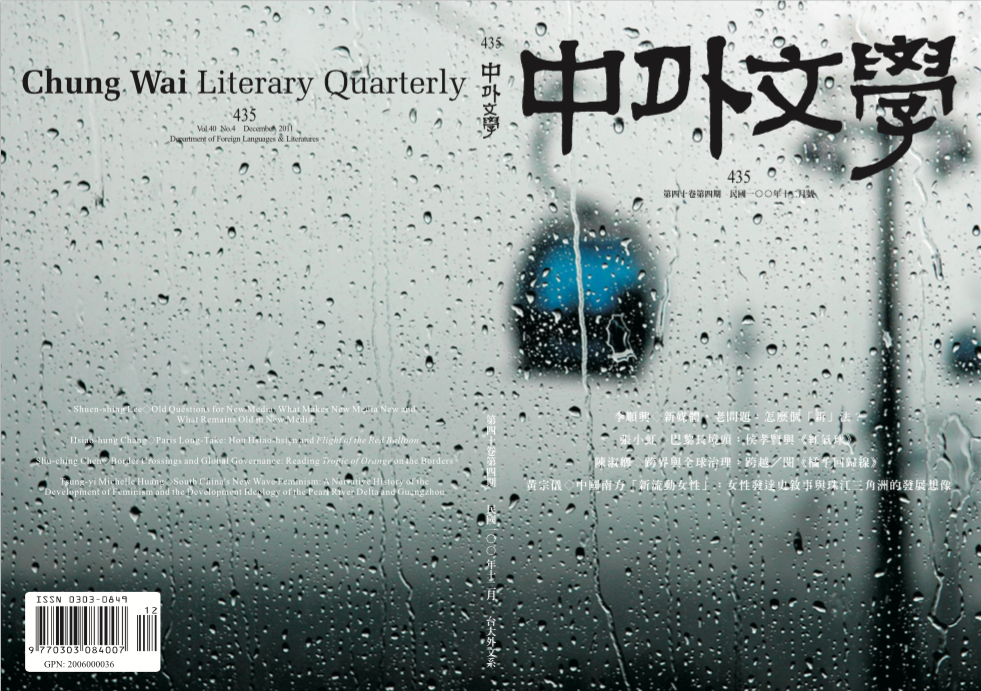第四十卷 第四期 總435 中華民國100年12月
Vol.40 No.4 December 2011

《中外文學》十二月號收錄了四篇精彩論文:李順興剖析漢森(Mark B. N. Hansen)對新媒體之「新」所下的定義,並試圖以體化(embodiment)的強度(intensity)作為測量值,檢視新媒體之新的內涵;張小虹以侯孝賢導演的法語片《紅氣球》為切入點,探討電影拍攝技法中的「長鏡頭」,企圖將「長鏡頭」轉換為「長境頭」,將對「(單)鏡頭」的關注,移轉到對「情境」的感應變化;陳淑卿從全球化多重權力治理的角度,討論當代亞美文學建置的跨國轉向與族裔越境遷移的多向性對當代族裔主體的衝擊,並以日裔美籍作家山下凱倫的小說《橘子回歸線》為例,討論書中各種臨界主體的越界矛盾;黃宗儀則解讀當代中國兩個大眾流行文本再現的新女性典範:《中國女首富張茵:從廢紙回收業到紙業女王》中的女性企業家,以及《杜拉拉升職記》中的高階白領女性,指出符合大眾想像的新女性形象建構之張力。
中外文學十二月號目錄
Contents
李順興╱新媒體,老問題:怎麼個「新」法?
新媒體,老問題
怎麼個「新」法?
李順興*
摘要
◎關鍵詞:新媒體,制動理論,體化,解體,再體化
★國立中興大學外國語文學系教授。
Shuen-shing Lee╱Old Questions for New Media: What Makes New Media New and What Remains Old in New Media
Old Questions for New Media
What Makes New Media New and What Remains
Old in New Media
Shuen-shing Lee*
Abstract
◎Keywords: new media, cybernetics, embodiment, disembodiment, reembodiment
★ Professor, Department of Foreign Languages and Literatures, National Chung Hsing University.
張小虹╱巴黎長境頭:侯孝賢與《紅氣球》
巴黎長境頭
侯孝賢與《紅氣球》
張小虹*
摘要
◎關鍵詞:長鏡頭,侯孝賢,《紅氣球》,情境,節奏,界域
★國立臺灣大學外國語文學系教授。
Hsiao-hung Chang╱Paris Long-Take: Hou Hsiao-hsien and Flight of the Red Balloon
Paris Long-Take
Hou Hsiao-hsien and Flight of the Red Balloon
Hsiao-hung Chang*
Abstract
◎Keywords: long take, Hou Hsiao-hsien, Flight of the Red Balloon, milieu, rhythm, territory
★ Professor, Department of Foreign Languages and Literatures, National Taiwan University.
陳淑卿╱跨界與全球治理: 跨越/閱《橘子回歸線》
跨界與全球治理
跨越/閱《橘子回歸線》
陳淑卿*
摘要
◎關鍵詞:生命政治,多重治理,治理性,新自由主義,邊境之地,反指揮/行動
★國立中興大學外國語文學系教授。
Shu-ching Chen╱Border Crossings and Global Governance: Reading Tropic of Orange on the Borders
Border Crossings and Global Governance
Reading Tropic of Orange on the Borders
Shu-ching Chen*
Abstract
◎Keywords: biopower, multiple forms of rule, governmentality, neo-liberalism, borderlands, counter conduct
★Professor, Department of Foreign Languages and Literatures, National Chung Hsing University.
黃宗儀╱中國南方「新流動女性」:女性發達史敘事與珠江三角洲的發展想像
中國南方「新流動女性」
女性發達史敘事與珠江三角洲的發展想像
黃宗儀*
摘要
◎關鍵詞:新流動女性,成功人士,白領菁英,珠江三角洲,廣州,世界城市典範,普通城市
★國立臺灣大學地理環境資源學系副教授。
Tsung-yi Michelle Huang╱South China’s New Wave Feminism: A Narrative History of the Development of Feminism and the Development Ideology of the Pearl River Delta and Guangzhou
South China’s New Wave Feminism
A Narrative History of the Development of Feminism and the Development Ideology of the Pearl River Delta and Guangzhou
Tsung-yi Michelle Huang*
Abstract
◎Keywords: new mobile woman, successful people, white collar, Pearl River Delta, Guangzhou, global-world city paradigm, ordinary city
★Associate Professor, Department of Geography, National Taiwan University.
